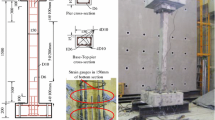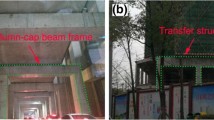Abstract
The loss tangent and storage modulus of cement mortar containing treated silica fume and styrene-acrylic are measured. Shaking table tests on three groups of 1/4 models of high damping concrete frames are conducted to compare the effects of reducing vibration. A relationship between the viscosity coefficient of high damping concrete and the damping coefficient of structure is established by analyzing dynamic parameters like damping ratio and frequency, and comparing responses of relative displacement and absolute acceleration. Surface treatment of silica fume and styrene-acrylic emulsion prior to incorporation in a cement mortar increases the loss tangent of the resulting composite by 40–400% as compared to the cement mortar without any admixtures, and the damping ratio of the reinforced concrete is raised by 7%–9%. In addition, a theoretical method of determining the viscosity coefficient of the material on the basis of shaking table test results is put forward.
Similar content being viewed by others
References
Wen S H, D D L Chung. Enhancing the Vibration Reduction Ability of Concrete by using Steel Reinforcement and Steel Surface Treatments[J]. Cement & Concrete Research, 2000 (30): 327–330
J P Ou, X C Guan. State-of-the Art of Smart Vibration Control of Civil Engineering Structures [J]. Earthquake Engineering and Engineering Vibration, 1999 (2): 21–28
J P Ou. Smart Concrete, Products and Structural Systems[M]. China-Japan Workshop on Vibration, Control and Health Monitoring of Structures, Shanghai, China, 2002: 4–5
X Fu, D D L Chung. Vibration Damping Admixture for Cement[J]. Cement & Concrete Research, 1996 (26): 69–75
X Fu, X H Li, D D L Chung. Improving the Vibration Damping Capacity of Cement[J]. Materials Science, 1998 (33): 3 601–3 605
Y Wang, D D L Chung. Effects of Sand and Silica Fume on the Vibration Damping Behavior of Cement[J]. Cement & Concrete Research, 1998 (28): 1 353–1 356
S H Wen, D D L Chung. Enhancing the Vibration Reduction Ability of Concrete by using Steel Reinforcement and Steel Surface Treatments[J]. Cement & Concrete Research, 2000 (30): 327–330
Y Xu, D D L Chung. Effect of Carbon Fibers on the Vibration-Reduction Ability of Cement[J]. Cement & Concrete Research, 1999 (29):1 107–1 109
Y Xu, D D L Chung. Improving Silica Fume Cement by using Silane[J]. Cement & Concrete Research, 2000 (30):1 305–1 311
D D L Chung. Cement-matrix Composites for Smart Structures[J]. Smart Materials and Structures, 2000 (9): 389–401
Y Xu, D D L Chung. Cement-based Materials Improved by Surface-treated Admixtures[J]. ACI Material Journal, 1997(3): 333–342
D D L Chung. Structural Composite Materials Tailored for Damping[J]. Journal of Alloys and Compounds, 2003; 355: 216–223
Author information
Authors and Affiliations
Corresponding author
Additional information
Funded by the National Naturnal Science Foundation of China (No. 50608025), Guangdong Provincial Natural Science Foundation of China (No.05300894), China Postdoctoral Science Foundation (No.20060390804)
Rights and permissions
About this article
Cite this article
Ou, J., Liu, T. & Li, J. Dynamic and seismic property experiments of high damping concrete and its frame models. J. Wuhan Univ. Technol.-Mat. Sci. Edit. 23, 1–6 (2008). https://doi.org/10.1007/s11595-006-1001-5
Received:
Accepted:
Issue Date:
DOI: https://doi.org/10.1007/s11595-006-1001-5




